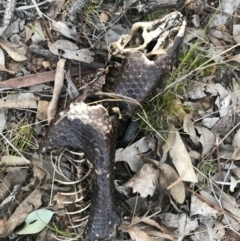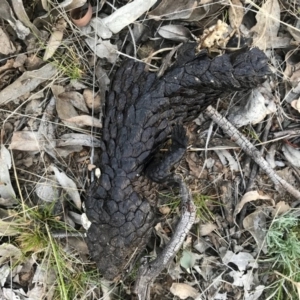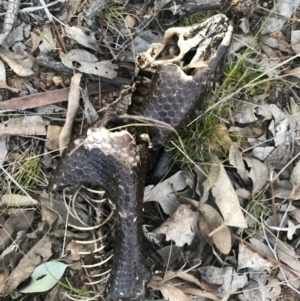Shingleback Lizard at Majura, ACT
Identification history
| Tiliqua rugosa | 3 Oct 2017 | MichaelMulvaney | ||
| Tiliqua rugosa | 3 Oct 2017 | AaronClausen |
Identify this sighting
Please Login or Register to identify this sighting.
3 comments
waltraud
wrote:
4 Oct 2017
Given the killed shinglebacks recorded on CNM are mainly along tracks where they are readily noticed the number of killed animals must be very high - I'm getting really concerned about the population of shinglebacks on mt majura's northwest slope. Has anyone an idea what is causing the injury (a hole at the animals vent)?
MichaelMulvaney
wrote:
4 Oct 2017
I suspect it is predation by a native bird such as a raven or kookaburra. Female shinglebacks give birth to a youngster that is 35% its body weight, compared to a human giving birth to a seven year old child. I had wondered whether this made females particularly vulnerable to predation, but this time of vulnerability would be in March and April. In terms of reports on Mt Ainslie Mt Majura the only other area in our region with a similar density of lizards is Mulligans Flat - Goorrooyaroo. It would be interesting to know if such predation has been reported there and inside the fence.
WillO
wrote:
4 Oct 2017
I agree all these Shingleback deaths are a worry. The photographic records of the dead individuals are important because we might be able to go through them and determine what proportion were emaciated (very thin with skin slumped down on backbone and loss of most tail fat). As i mentioned in an earlier comment some dogs become very good at killing them. Someone walking their dog off lead could be a problem if their dog kills reptiles. These animals typically are bitten and shaken around tearing open or puncturing the body cavity. As mentioned by Michael, damage to the region of the vent is likely to be a raven (feeding from a dead individual) or perhaps a fox (that killed it) - the easy way in is via the cloaca. I have wondered how shinglebacks are going in areas with high kangaroo density (like Ainslie-Majura). This is because the shingleback is very dependent on soft herbage and flowers for food - ie the same resources reduced by kangaroos. Measurement (including weight) of individuals caught in the roo exclosures could be compared to measurements from individuals in areas with evidence of high kangaroo density. This looks like being a drought summer and it could be a good study to do this summer. WillO
Please Login or Register to comment.
Nearby sightings
Location information
- Coordinates 149.176117-35.227821
- Altitude 686.0m
- Maps Mount Majura
- Places Majura, ACT
Sighting information
- 1 Abundance
- 3 Oct 2017 07:05 PM Recorded on
- AaronClausen Recorded by
Species information
- Tiliqua rugosa Scientific name
- Shingleback Lizard Common name
- Not Sensitive
- Local native
- Non-Invasive
- Up to 888.04m Recorded at altitude
- 331 images trained Machine learning
Record quality
- Images or audio
- More than one media file
- Confirmed by an expert moderator
- Nearby sighting(s) of same species
- GPS evidence of location
- Description
- Additional attributes

























